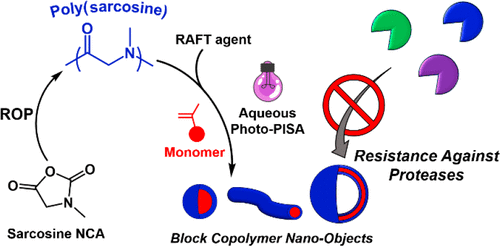当前位置:
X-MOL 学术
›
Biomacromolecules
›
论文详情
Our official English website, www.x-mol.net, welcomes your
feedback! (Note: you will need to create a separate account there.)
Poly(sarcosine)-Based Nano-Objects with Multi-Protease Resistance by Aqueous Photoinitiated Polymerization-Induced Self-Assembly (Photo-PISA)
Biomacromolecules ( IF 5.5 ) Pub Date : 2018-10-23 00:00:00 , DOI: 10.1021/acs.biomac.8b01326 Spyridon Varlas 1 , Panagiotis G. Georgiou 1, 2 , Panayiotis Bilalis 3 , Joseph R. Jones 1 , Nikos Hadjichristidis 3 , Rachel K. O’Reilly 1
Biomacromolecules ( IF 5.5 ) Pub Date : 2018-10-23 00:00:00 , DOI: 10.1021/acs.biomac.8b01326 Spyridon Varlas 1 , Panagiotis G. Georgiou 1, 2 , Panayiotis Bilalis 3 , Joseph R. Jones 1 , Nikos Hadjichristidis 3 , Rachel K. O’Reilly 1
Affiliation

|
Poly(sarcosine) (PSar) is a non-ionic hydrophilic polypeptoid with numerous biologically relevant properties, making it an appealing candidate for the development of amphiphilic block copolymer nanostructures. In this work, the fabrication of poly(sarcosine)-based diblock copolymer nano-objects with various morphologies via aqueous reversible addition–fragmentation chain-transfer (RAFT)-mediated photoinitiated polymerization-induced self-assembly (photo-PISA) is reported. Poly(sarcosine) was first synthesized via ring-opening polymerization (ROP) of sarcosine N-carboxyanhydride, using high-vacuum techniques. A small molecule chain transfer agent (CTA) was then coupled to the active ω-amino chain end of the telechelic polymer for the synthesis of a poly(sarcosine)-based macro-CTA. Controlled chain-extensions of a commercially available water-miscible methacrylate monomer (2-hydroxypropyl methacrylate) were achieved via photo-PISA under mild reaction conditions, using PSar macro-CTA. Upon varying the degree of polymerization and concentration of the core-forming monomer, morphologies evolving from spherical micelles to worm-like micelles and vesicles were accessed, as determined by dynamic light scattering and transmission electron microscopy, resulting in the construction of a detailed phase diagram. The resistance of both colloidally stable empty vesicles and enzyme-loaded nanoreactors against degradation by a series of proteases was finally assessed. Overall, our findings underline the potential of poly(sarcosine) as an alternative corona-forming polymer to poly(ethylene glycol)-based analogues of PISA assemblies for use in various pharmaceutical and biomedical applications.
中文翻译:

通过水光引发聚合诱导的自组装(Photo-PISA)具有多蛋白酶抗性的基于聚肌氨酸的纳米物体。
聚肌氨酸(PSar)是一种具有多种生物学相关特性的非离子亲水性类肽,使其成为两亲嵌段共聚物纳米结构开发的诱人候选物。在这项工作中,报道了通过水可逆加成-断裂链转移(RAFT)介导的光引发聚合诱导的自组装(photo-PISA)制备具有各种形态的聚(肌氨酸)二嵌段共聚物纳米物体。首先通过肌氨酸N的开环聚合(ROP)合成聚肌氨酸-羧基酸酐,使用高真空技术。然后将小分子链转移剂(CTA)偶联至远螯聚合物的活性ω-氨基链末端,以合成基于聚肌氨酸的大分子CTA。使用PSar macro-CTA,在温和的反应条件下,通过光-PISA可实现可商购的与水混溶的甲基丙烯酸甲酯单体(甲基丙烯酸2-羟丙酯)的受控链延长。通过改变聚合度和成核单体的浓度,可以通过动态光散射和透射电子显微镜确定从球形胶束到蠕虫状胶束和囊泡的形貌,从而构建了详细的相图。最后评估了胶体稳定的空囊泡和负载酶的纳米反应器对一系列蛋白酶降解的抵抗力。总的来说,我们的发现强调了聚肌氨酸作为PISA组件基于聚乙二醇的类似物的替代电晕形成聚合物的潜力,可用于各种制药和生物医学应用。
更新日期:2018-10-23
中文翻译:

通过水光引发聚合诱导的自组装(Photo-PISA)具有多蛋白酶抗性的基于聚肌氨酸的纳米物体。
聚肌氨酸(PSar)是一种具有多种生物学相关特性的非离子亲水性类肽,使其成为两亲嵌段共聚物纳米结构开发的诱人候选物。在这项工作中,报道了通过水可逆加成-断裂链转移(RAFT)介导的光引发聚合诱导的自组装(photo-PISA)制备具有各种形态的聚(肌氨酸)二嵌段共聚物纳米物体。首先通过肌氨酸N的开环聚合(ROP)合成聚肌氨酸-羧基酸酐,使用高真空技术。然后将小分子链转移剂(CTA)偶联至远螯聚合物的活性ω-氨基链末端,以合成基于聚肌氨酸的大分子CTA。使用PSar macro-CTA,在温和的反应条件下,通过光-PISA可实现可商购的与水混溶的甲基丙烯酸甲酯单体(甲基丙烯酸2-羟丙酯)的受控链延长。通过改变聚合度和成核单体的浓度,可以通过动态光散射和透射电子显微镜确定从球形胶束到蠕虫状胶束和囊泡的形貌,从而构建了详细的相图。最后评估了胶体稳定的空囊泡和负载酶的纳米反应器对一系列蛋白酶降解的抵抗力。总的来说,我们的发现强调了聚肌氨酸作为PISA组件基于聚乙二醇的类似物的替代电晕形成聚合物的潜力,可用于各种制药和生物医学应用。











































 京公网安备 11010802027423号
京公网安备 11010802027423号